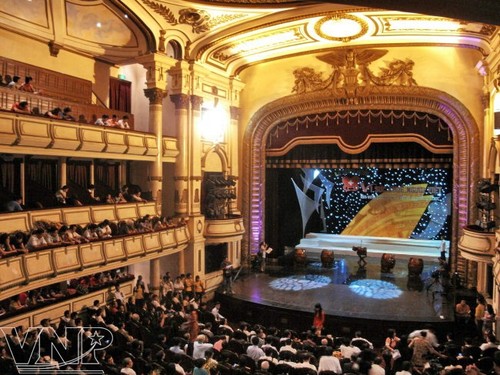 Inside the Hanoi Opera House in Hanoi (photo: VNP) Inside the Hanoi Opera House in Hanoi (photo: VNP) |
B: We’re happy that our audience is growing every day, and listening to our programs on air and online from every corner of the world. VOV’s frequency of 7220khz spans South Asia and always has a good signal.
A: Muhammad Aqeel Bashir, Head of Pak Listeners Club of Pakistan, said he tuned in to VOV’s English program on March 24th on the frequency of 7220khz. He rated SIO at all 4s.
B: Abdul Mannan of Bangladesh also tuned in the frequency of 7220khz. It gave a good signal and clear sound with SIO at 544. He told us: “I was listening to your program on Monday with excellent reception. Today I got your email. I was very happy. If you have a chance please send me a letter.”
A: Ratan Kumar Paul of India often listens to VOV’s English program at 16:00UTC on the frequency of 7220khz. The program on March 16th had a good signal as usual with SINPO at all 4s. He attached audio clips of the program for us to listen to.
B: Siddhartha Bhattacharjee of India tuned in to our program on March 23 on the frequency of 7220khz using a receiver model Xdata 808. The audio was good with the overall quality at 4.
A: Christer Brunström of Sweden reported that the frequency of 11885 kHz was not perfect when he tuned in on March 23 using a Sangean receiver. It was audible with SINPO at 35443.
B: Thank you all for monitoring our transmission and sending us your feedback.
A: Last week Siddhartha Bhattacharjee of India asked us: “Do you like theater?”
B: Vietnam’s thousand-year-old culture is so rich in theatrical tradition and each region seems to have its own operatic genre. The north has Cheo, a popular genre of theatre that has its roots in ancient village festivals. Cheo is considered the oldest and most popular folk music performance in Vietnam. Now almost all northern Red River Delta provinces have a Cheo troupe.
A: A Cheo performance consists of folk songs with pantomime, instrumental music and dances, combined with instructive or interpretive sketches with stories from legends, poetry, history and daily life, plus acrobatic scenes and magic.
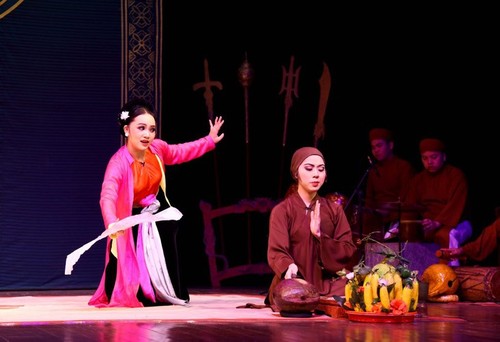 A famous scene "Thi Mau goes to the pagoda" in the Cheo play "Quan Am Thi Kinh" performed by artists of the Vietnam Cheo Theater (photo: Vietnam Cheo Theater) A famous scene "Thi Mau goes to the pagoda" in the Cheo play "Quan Am Thi Kinh" performed by artists of the Vietnam Cheo Theater (photo: Vietnam Cheo Theater) |
B: The characters are the soul of the play. Cheo uses standard characters – usually a hero, a heroine, and a clown – who are instantly recognizable to the audience by their clothes, accessories, and make-up. Cheo stories may be romantic or tragic but the clown or buffoon always comments on the action in an amusing or satirical way as well as mocks the pompous, ridiculous or dishonest characters.
A: A Cheo play is not complete without a stage. The play could be put on the stage of a large theatre, but also performed successfully on one or two bed mats spread in the middle of a communal house. The Cheo drum is typically used to create energy in the play, and upon hearing it, people cannot resist coming to see the performance.
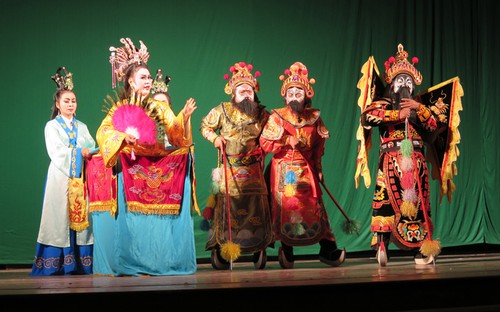 A Tuong performance by the Nguyen Hien Dinh Theater of Da Nang city (Illustrative photo: VOV) A Tuong performance by the Nguyen Hien Dinh Theater of Da Nang city (Illustrative photo: VOV) |
B: Tuong or classical opera is originally an entertainment form for royalty. It soon took to the road with travelling ensembles. As with Cheo, characters are defined by their unique costumes and makeup. The stories deal with historic events and legends interwoven with Confucian dictates.
A: Cai luong or reformed theater is a sort of modern folk musical operetta of the south. Costumed performers sing and dance their way through comedies and dramatic stories that emphasize moral values such as solidarity, lifelong learning, fidelity, hard work, and self-sacrifice.
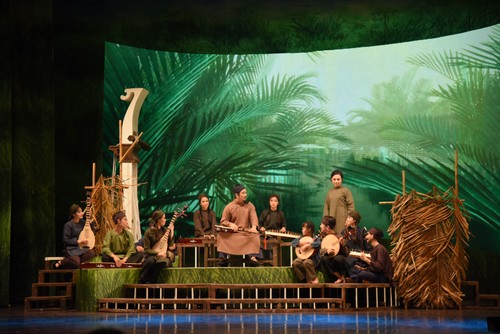 A Cai Luong play "Thay Ba Doi" written by Associate Professor, Doctor Nguyen The Ky (photo: VOV) A Cai Luong play "Thay Ba Doi" written by Associate Professor, Doctor Nguyen The Ky (photo: VOV) |
B: Water puppetry, though it originated in the northern Red River Delta, is a popular theatre art in many places across Vietnam. Wooden puppets manipulated by hidden puppeteers glide over a shallow pool of water as folk tales and legends are acted out to accompanying music.
A: Its history dates back a thousand years ago. After rice harvesting, farmers often gathered for a community celebration and entertainment. About one thousand years ago, water puppets were added to the list of performances at the festivals. The first shows were performed on harvested paddy fields filled with water to create a watery stage.
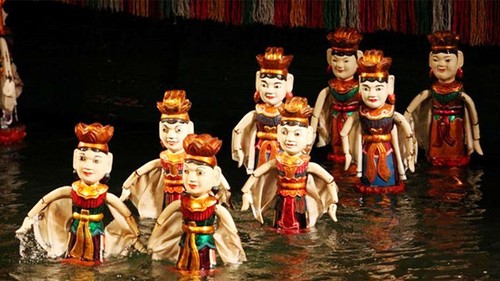 Water puppetry (illustrative photo) Water puppetry (illustrative photo) |
B: Today Vietnam’s water puppet shows are not presented in flooded paddy fields but in a pool theater. These pools are decorated with red tiered roofs, flags, and parasols to resemble an altar inside Vietnamese communal houses. On both sides of the stage sit the musical ensemble who bring the stories to life by singing and playing traditional instruments.
A: Water puppetry is a physically demanding craft. Puppeteers stand in water throughout the show to steer the puppets and use the movement of the water to create drama, perfect the illusion, and tell a story. The puppeteers’ secret lies in the material of the puppets themselves, which are made of buoyant fig wood and painted with lacquer.
B: Tourists to Vietnam can easily find puppetry theaters on tourist maps. Top puppetry theaters are the Thang LongWater Puppetry Theater andthe Vietnam National Puppetry Theater in Hanoi and the Rong Vang Water Puppetry Theater in Ho Chi Minh City.
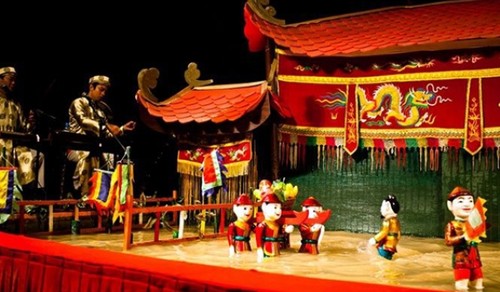 Water puppetry show (illustrative photo) Water puppetry show (illustrative photo) |
A: Around the same time, a western genre of performing art called kichnoi (straight play), also made its debut in the country. The first French play, representing the western theatrical art, performed in Hanoi in Vietnamese language premiered in Hanoi’s Opera House in 1920. It was “The Imaginary Invalid by Molière. During that time, such plays were only popular among the ruling French and some western-trained local intellectuals.
B: About one and a half years after the Molière premiere, Vietnamese playwright Vu Dinh Long presented his play “The Cup of Poison” at Hanoi's Opera House, and more local playwrights began penning their own scripts. This genre celebrated its 100th anniversary in Vietnam last year.
A: Thank you all for listening to VOV and writing to us. We welcome your comments and suggestions at English Service, VOVworld, the Voice of Vietnam, 45 Ba Trieu street, Hanoi, Vietnam.
B: Our email address is: englishsection@vov.vn. You’re invited to visit us online and leave your comments at vovworld.vn. Once again, thank you all for listening. Goodbye.